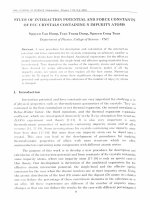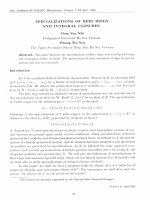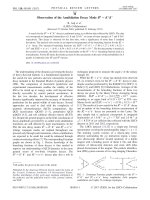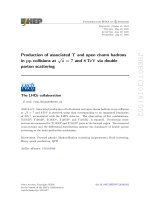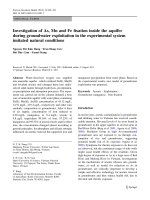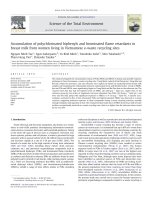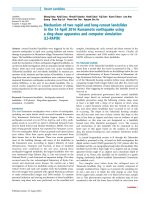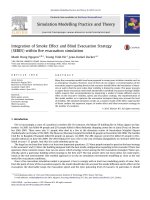DSpace at VNU: Observation of B-s(0) - (D)over-bar(0)K(S)(0) and Evidence for B-s(0) - (D)over-bar K-0(S)0 Decays
Bạn đang xem bản rút gọn của tài liệu. Xem và tải ngay bản đầy đủ của tài liệu tại đây (295.15 KB, 9 trang )
PRL 116, 161802 (2016)
PHYSICAL REVIEW LETTERS
week ending
22 APRIL 2016
Observation of B0s → D¯ 0 K 0S and Evidence for B0s → D¯ Ã0 K 0S Decays
R. Aaij et al.*
(LHCb Collaboration)
(Received 9 March 2016; published 21 April 2016)
¯ 0 K 0S decay mode and evidence for the B0s → D
¯ Ã0 K 0S decay mode are
The first observation of the B0s → D
reported. The data sample corresponds to an integrated luminosity of 3.0 fb−1 collected in pp collisions by
LHCb at center-of-mass energies of 7 and 8 TeV. The branching fractions are measured to be
¯ 0 K¯ 0 Þ ¼ ½4.3 Æ 0.5ðstatÞ Æ 0.3ðsystÞ Æ 0.3ðfragÞ Æ 0.6ðnormÞ × 10−4 ;
BðB0s → D
¯ Ã0 K¯ 0 Þ ¼ ½2.8 Æ 1.0ðstatÞ Æ 0.3ðsystÞ Æ 0.2ðfragÞ Æ 0.4ðnormÞ × 10−4 ;
BðB0s → D
where the uncertainties are due to contributions coming from statistical precision, systematic effects, and
¯ 0 K 0S , which is
the precision of two external inputs, the ratio f s =f d and the branching fraction of B0 → D
used as a calibration channel.
DOI: 10.1103/PhysRevLett.116.161802
The study of CP violation is one of the most important
topics in flavor physics. In B0 decays, the phenomenon of
CP violation has been extensively studied at BABAR, Belle,
and LHCb, which confirmed many predictions of the
standard model (SM) [1–4]. Nowadays, the focus is on
the search for beyond the standard model (BSM) effects by
improving the statistical precision of the CP violation
parameters and looking for deviations from the SM
predictions.
In the SM, violation of CP symmetry in B decays is
commonly parametrized by three phase angles (α, β, γ)
derived from the Cabibbo-Kobayashi-Maskawa matrix,
which describes the charged-current interactions among
quarks [5]. Since the angles sum up to 180°, any deviation
found in measurements of the phases would be a sign of
BSM physics affecting at least one of the results. Currently
the angle γ is only known with an uncertainty of about 10°
[6]; experimental efforts are required to improve its
precision and thus the sensitivity to BSM effects.
Another sensitive observable is the B0s mixing phase, ϕs ,
which in the SM is predicted with good precision to be
close to zero [7]. Any significant deviation here would also
reveal physics BSM [8,9]. The current uncertainty is
Oð0.1Þ rad [6].
In this Letter, two decay modes that can improve the
¯ 0 K 0S decay
knowledge of γ and ϕs are studied. The B0 → D
[10] offers a determination of the angle γ with small
¯ ðÃÞ0 K 0S , similar
theoretical uncertainties [11], while B0s → D
*
Full author list given at the end of the article.
Published by the American Physical Society under the terms of
the Creative Commons Attribution 3.0 License. Further distribution of this work must maintain attribution to the author(s) and
the published article’s title, journal citation, and DOI.
0031-9007=16=116(16)=161802(9)
¯ ðÃÞ0 ϕ [12] mode, provides sensitivity to ϕs
to the B0s → D
with a theoretical accuracy of Oð0.01Þ rad [13].
¯ ðÃÞ0 K 0S has been seen at the B
While the decay B0 → D
0
ðÃÞ0
¯
factories [14], Bs → D
K 0S decays have not previously
been observed. Theoretical predictions of their branching
fractions are of the order of 5 × 10−4 [15–17]. This Letter
¯ 0 K 0S and evidence
reports the first observation of B0s → D
0
Ã0 0
¯
for Bs → D K S decays, and it provides measurements
of branching fractions of these channels normalized to
¯ 0 K 0S decays.
B0 → D
The analysis is based on data collected in pp collisions
pffiffiffi
by the LHCb experiment at s ¼ 7 and 8 TeV corresponding to an integrated luminosity of 3.0 fb−1 . The LHCb
detector [18,19] is a single-arm forward spectrometer
covering the pseudorapidity range 2 < η < 5, designed
for the study of particles containing b or c quarks. The
detector includes a high-precision tracking system consisting of a silicon-strip vertex detector surrounding the pp
interaction region, a large-area silicon-strip detector located
upstream of a dipole magnet with a bending power of about
4 T m, and three stations of silicon-strip detectors and straw
drift tubes placed downstream of the magnet. The tracking
system provides a measurement of momentum, p, of
charged particles with a relative uncertainty that varies
from 0.5% at low momentum to 1.0% at 200 GeV=c. Two
ring-imaging Cherenkov (RICH) detectors are able to
discriminate between different species of charged hadrons.
The online event selection is performed by a trigger, which
consists of a hardware stage, based on information from the
calorimeter and muon systems, followed by a software
stage, which applies a full event reconstruction.
In the simulation, pp collisions are generated using
PYTHIA [20] with a specific LHCb configuration [21].
Decays of hadronic particles are described by EVTGEN
161802-1
© 2016 CERN, for the LHCb Collaboration
PRL 116, 161802 (2016)
week ending
22 APRIL 2016
PHYSICAL REVIEW LETTERS
[22], in which final-state radiation is generated using
PHOTOS [23]. The interaction of the generated particles
with the detector, and its response, are implemented using
the GEANT4 toolkit [24] as described in Ref. [25].
At the hardware trigger stage, events are required to have
a muon with high pT or a hadron, photon, or electron with
high transverse energy deposited in the calorimeters. The
software trigger requires a two-, three-, or four-track
secondary vertex with a significant displacement from
any reconstructed primary vertex (PV). At least one of
these tracks must have pT > 1.7 GeV=c and be inconsistent with originating from a PV. A multivariate algorithm
[26] is used to identify secondary vertices consistent with
the decay of a b hadron.
Candidate K 0S → π þ π − decays are reconstructed in two
different categories, the first involving K 0S mesons that
decay early enough for the daughter pions to be reconstructed in the vertex detector, referred to as long, and the
second containing K 0S ’s that decay later, such that track
segments of the pions cannot be formed in the vertex
detector, referred to as downstream. The long category has
better mass, momentum, and vertex resolution than the
downstream category. Long (downstream) K 0S candidates
are required to have decay lengths larger than 12 (9) times
the decay length uncertainty. The invariant mass of the
candidate is required to be within 30 MeV=c2 of the known
K 0S mass [27].
¯ 0 → K þ π − candidates are formed from combinaThe D
tions of kaon and pion candidate tracks identified by the
RICH detectors. The pion (kaon) must have p >
1ð5Þ GeV=c and pT > 100ð500Þ MeV=c, and it must be
inconsistent with originating from a PV. The invariant mass
of the candidate is required to be within 50 MeV=c2 of the
¯ 0 mass [27].
known D
¯0
The B (B0 or B0s ) candidate is formed by combining D
0
and K S candidates and requiring an invariant mass in the
range 4500–7000 MeV=c2 , a decay time greater than
0.2 ps, and a momentum vector pointing back to the
associated PV. To improve the mass resolution of the B
candidates, a kinematic fit is performed constraining the
¯ 0 and K 0S candidates to the known
masses of the D
values [27].
The purity of the B candidate sample is then increased by
means of a multivariate classifier [28,29] that separates the
signal from the combinatorial background. Separate algorithms are trained for candidates with long and downstream
K 0S candidates. The discriminating variables used in the
classifier are the χ 2 of the kinematic fit, geometric variables
¯ 0 , and K 0S , the decay
related to the finite lifetime of the B, D
time, and the pT and p of the K 0S candidate. The
multivariate classifier is trained and tested using signal
candidates from simulations and background candidates
from data in the upper sideband of the B mass spectrum,
¯ 0 K 0S Þ > 5500 MeV=c2 , where no
corresponding to mðD
backgrounds are expected from B decays in which a
photon or a π meson is not reconstructed. The selection
is optimized to minimize the statistical uncertainty on
the ratio of B0s over B0 signal event yields. The signal
efficiency and background rejection factors are 76% and
98%, respectively. B candidates in the mass range
5000–5900 MeV=c2 are retained. Multiple candidates
occur in 0.2% (0.4%) of long (downstream) K 0S events,
in which case one candidate, chosen at random, is kept.
The B0s and B0 signal yields in the selected sample are
obtained from an unbinned extended maximum likelihood
fit simultaneously performed on the long and downstream
K 0S samples. The observables used in the fit are mK0S , the
mass of the K 0S → π þ π − candidates, mD¯ 0 , the mass of the
¯ 0 → K þ π − candidates, and mB , the mass of the B meson
D
candidates. The probability density function (PDF) contains four terms,
PðmD¯ 0 ; mK0S ; mB Þ ¼
¼
4
X
i¼1
4
X
i¼1
N i F i ðmD¯ 0 ; mK0S ; mB Þ
N i P i ðmB ÞS i ðmD¯ 0 ; mK0S Þ;
ð1Þ
where N i represents the respective yield, P i parametrizes
the mass distribution of the B meson candidates and S i is
the joint PDF of the candidates for its decay products. The
¯ 0 and K 0S
term F 1 describes correctly reconstructed D
0
¯
candidates, F 2 a correctly reconstructed D meson in
association with two random pions, F 3 a correctly reconstructed K 0S meson in association with a random kaon and
pion, and F 4 random combinations of the four final-state
particles. Johnson SU distributions [30], characterized by
asymmetric tails to account for radiative losses and vertex
¯0
reconstruction uncertainties, are used to parametrize the D
0
and K S signals in S 1;2;3 , and exponential functions describe
the backgrounds in S 2;3;4 .
The B mass in candidates with correctly reconstructed
¯ 0 and K 0S mesons (P 1 ) is described by three categories of
D
¯ 0 K 0S signal, peaking structures at
shapes: the B0ðsÞ → D
lower mass from other B decays, and the combinatorial
background. Signal shapes for the B0 and B0s candidates
¯ 0 K 0S are described by means of Johnson SU
decaying to D
distributions with shape parameters determined from fits to
the simulated signal samples, corrected for differences
between the simulation and the data. The peaking structures
at lower mass correspond to decays of B0 and B0s mesons
¯ 0 and K 0S mesons in the final state where a
that include D
photon or a π meson is not reconstructed, such as B0ðsÞ →
¯ Ã0 ðD
¯ 0 π 0 ÞK 0S , B0 → D
¯ Ã0 ðD
¯ 0 γÞK 0S , Bþ → D
¯ 0 K Ãþ ðK 0S π þ Þ,
D
ðsÞ
¯ 0 K Ã0 ðK 0S π 0 Þ. These shapes are described with
and B0ðsÞ → D
kernel estimated PDFs [31] obtained from simulation.
The same exponential function is used for the combinatorial background description of the B mass distribution
¯ 0πþπ−
in P 1;2;3;4 . Possible contaminations from B0ðsÞ → D
¯ Ã0 π þ π − in P 2 , and B0 → K 0S K þ π − and
and B0ðsÞ → D
ðsÞ
161802-2
40
20
1.82 1.84 1.86 1.88
1.9
Events / (9 MeV/c 2)
40
20
0.5
LHCb
B0s → D0K *0
B0→ D0K *0
Combin. (D0K 0S)
K +π-K 0S
D0π+πCombinatorial
20
ð3Þ
(e)
LHCb
80
60
40
20
0
0.51 0.52
1.82 1.84 1.86 1.88
1.9
60
LHCb
40
20
0
0.47 0.48 0.49
1.92
m(K+π-) (GeV/c 2)
B0(s)→ D0K 0S
0
B0s → D*0(D0γ )K S
B0→ D*0(D0γ )K 0S
B0s → D*0(D0π0)K 0S
B0→ D*0(D0π0)K 0S
40
05
(d)
m(π+π-) (GeV/c 2)
(c)
60
LHCb
¯ ðÃÞ0 K 0S Þ
fd
NðB0s → D
ϵB0
0
0
0
0
0
0
¯
¯
¯
f s NðB → D K S Þ þ NðB → D K S Þ ϵB0s
is the product of the production ratio of B0 over B0s decays
in LHCb (f d =fs ), the ratio of reconstructed B0s and B0
100
0
0.47 0.48 0.49
1.92
m(K +π-) (GeV/c 2)
RðÃÞ ¼
(b)
60
ð2Þ
¯ 0 K 0 Þ þ BðB¯ 0 → D
¯ 0 K¯ 0 Þ since the
where Bsum ¼ BðB0 → D
0
analysis does not distinguish between K and K¯ 0 . The
quantity
0.5
0.51 0.52
m(π+π-) (GeV/c 2)
0
B(s)
→ D0K 0S
0
0
Bs → D*0(D0γ )K S
B0→ D*0(D0γ )K 0S
B0s → D*0(D0π0)K 0S
B0→ D*0(D0π0)K 0S
(f)
80
Events / (9 MeV/c 2)
0
¯ ðÃÞ0 K¯ 0 Þ ¼ RðÃÞ × Bsum ;
BðB0s → D
Events / (0.54 MeV/c 2)
LHCb
¯ 0 K 0S Þ ¼ 219 Æ 21, NðB0s →
from the fit are NðB0 → D
0 0
¯ Ã0 K 0S Þ ¼ 258 Æ 83,
¯
D K S Þ ¼ 471 Æ 26 and NðB0s → D
where the uncertainties are purely statistical.
¯ ðÃÞ0 K¯ 0 decays
The branching fractions, B, of the B0s → D
are calculated from the ratio of branching fractions between
B0s and B0 ,
Events / (1.1 MeV/c 2)
(a)
Events / (0.54 MeV/c 2)
Events / (1.1 MeV/c 2)
B0ðsÞ → K Ã0 ðK 0S π 0 ÞK þ π − in P 3 are accounted for using the
function that describes the B0ðsÞ candidates in P 1 .
The PDFs F i are distinct for the long and downstream
samples but share certain parameters, including those of the
¯ 0 signal distribution and the yield fractions of the nonD
combinatorial components of the B mass spectrum.
Gaussian constraints are applied to the branching fraction
¯ 0 K Ã0 Þ=½BðB0 → D
¯ 0 K Ã0 ÞþBðB0s → D
¯ 0 K Ã0 Þ
ratios BðB0s → D
0
0
Ã0 ¯ 0 0
0
Ã0 ¯ 0
¯
¯
and B(BðsÞ → D ðD π ÞK )=½B(BðsÞ → D ðD γÞK 0 )þ
¯ Ã0 ðD
¯ 0 π 0 ÞK 0 ). These constraints improve the
B(B0ðsÞ → D
stability of the fit and are determined from measurements of
branching fractions reported in Ref. [27], corrected by the
efficiencies of the relevant B0ðsÞ decays as determined from
simulated samples.
Projections of the fit results on the data sample are shown
in Fig. 1. The numbers of signal candidates determined
60
week ending
22 APRIL 2016
PHYSICAL REVIEW LETTERS
PRL 116, 161802 (2016)
LHCb
60
B0s → D0K *0
B0→ D0K *0
Combin. (D0K 0S)
K +π-K 0S
40
D0π+πCombinatorial
20
5.2
5.4
m(D 0K 0S)
5.6
0
5.8
(GeV/c 2)
5
5.2
5.4
5.6
5.8
m(D 0K 0S) (GeV/c 2)
¯ 0 candidate (a),(d), the K 0S candidate
FIG. 1. The projection of the fit results (solid line) on the data sample (points) is shown for the D
0
(b),(e), and B candidate (c),(f) mass spectra. The long K S sample is shown in (a)–(c), and the downstream sample in (d)–(f). The
¯ 0 and K 0 candidate mass plots represents events corresponding to background categories S 2;3;4 in the fit and includes
dashed line in the D
S
¯ 0 mesons paired with two random pions. The double-peak behavior of the B0 → D
¯ Ã0 ðD
¯ 0 π 0 ÞK 0 shape
peaks due to, for example, real D
S
ðsÞ
¯ Ã0 → D
¯ 0 π 0 decay.
is due to the missing momentum of the π 0 and the helicity amplitude of the D
161802-3
PRL 116, 161802 (2016)
TABLE I.
Source
Fit model
ϵB0 =ϵB0s
fs =f d
Bsum
PHYSICAL REVIEW LETTERS
Summary of the systematic uncertainties.
¯ 0 K 0S
B0s → D
¯ Ã0 K 0S
B0s → D
5.4%
2.4%
11.9%
2.5%
5.8%
13.5%
signal candidates, and the ratio of efficiencies of B0 to B0s
¯ ðÃÞ0 K 0S in the LHCb detector
candidates decaying to D
(ϵB0 =ϵB0s ). The value of f s =f d ¼ 0.259 Æ 0.015 is provided
by previous LHCb measurements [32,33]. The ratios of
efficiencies ϵB0 →D¯ 0 K0S =ϵB0s →D¯ 0 K0S ¼ 0.997 Æ 0.024 and
ϵB0 →D¯ 0 K0S =ϵB0s →D¯ Ã0 K0S ¼ 1.181 Æ 0.029 are obtained from
simulated samples. The ratio of B0s and B0 signal candidates
is a free parameter in the fit and is measured to be NðB0s →
¯ 0 K 0S Þ þ NðB¯ 0 → D
¯ 0 K 0S Þ ¼ 2.15 Æ 0.23.
¯ 0 K 0S Þ=½NðB0 → D
D
0
Ã0 0
¯
¯ 0 K 0S Þ þ
Similarly, the ratio NðBs → D K S Þ=½NðB0 → D
0
0
0
¯
¯
NðB → D K S Þ ¼ 1.17 Æ 0.44 is measured.
Various sources of systematic uncertainty have been considered. These are summarized in Table I and discussed
below.
The uncertainty associated with the fit model is assessed
by the use of other functions for the PDFs P i and S i . For
the mass distribution of the signal events, four alternative
models are used. Each pseudoexperiment generated in this
way is then fitted with the baseline model, and the difference of the signal yields ratio with respect to the generated
value is considered. The mean of the distribution that shows
the largest deviation from zero is taken as the systematic
uncertainty, corresponding to 5.4% (11.9%) for B0s →
¯ Ã0 K 0S ).
¯ 0 K 0S (B0s → D
D
The ratio of efficiencies of the B0 and B0s decays is
determined from simulation and is limited by the finite size
of the sample. The statistical uncertainties on the efficiency
ratios and the statistical uncertainties of the external inputs,
f s =f d and the branching fraction Bsum , are propagated to
the systematic uncertainty of this measurement.
To test the stability of the result with respect to the offline selection, the measurement is repeated at different
week ending
22 APRIL 2016
selection cuts on the multivariate classifier. The deviations
from the nominal result are consistent with statistical
fluctuations and no systematic uncertainty is assigned.
Possible bias due to the random removal of multiple
candidates is tested by removing or keeping all of them,
and no significant effect is observed.
Further cross-checks on the stability of the result are
made by measuring the branching fractions independently
for the long and downstream K 0S samples, for the two
different polarities of the LHCb magnet and for different
running conditions. No significant effect is observed.
Only the fit model is considered when determining the
systematic uncertainty on the number of signal candidates.
The statistical uncertainty on the efficiencies and on f s =fd
are also included in the sum in quadrature to give the
systematic uncertainty on the ratio of branching fractions
RðÃÞ . Finally, the uncertainty on Bsum is also included
for the measurement of the branching fraction
¯ ðÃÞ0 K¯ 0 Þ.
BðB0s → D
Signal yields of
¯ 0 K 0S Þ ¼ 219 Æ 21ðstatÞ Æ 11ðsystÞ;
NðB0 → D
¯ 0 K 0S Þ ¼ 471 Æ 26ðstatÞ Æ 25ðsystÞ;
NðB0s → D
¯ Ã0 K 0S Þ ¼ 258 Æ 83ðstatÞ Æ 30ðsystÞ
NðB0s → D
are found. Those results correspond to the first observation
¯ 0 K 0S decay with a significance of 13.1
of the B0s → D
¯ Ã0 K 0S with a
standard deviations and evidence for B0s → D
significance of 4.4 standard deviations, where the significances are calculated using Wilks’s theorem [34].
The ratios of the branching fractions are
R ¼ 8.3 Æ 0.9ðstatÞ Æ 0.5ðsystÞ Æ 0.5ðfragÞ;
RÃ ¼ 5.4 Æ 2.0ðstatÞ Æ 0.7ðsystÞ Æ 0.3ðfragÞ:
Here, the correlation coefficient between the two statistical
uncertainties is 68% and that between the two systematic
uncertainties is 49%. Using the branching fraction Bsum ¼
ð5.2 Æ 0.7Þ × 10−5 [27], the values of the branching fractions are
¯ 0 K¯ 0 Þ ¼ ½4.3 Æ 0.5ðstatÞ Æ 0.3ðsystÞ Æ 0.3ðfragÞ Æ 0.6ðnormÞ × 10−4 ;
BðB0s → D
¯ Ã0 K¯ 0 Þ ¼ ½2.8 Æ 1.0ðstatÞ Æ 0.3ðsystÞ Æ 0.2ðfragÞ Æ 0.4ðnormÞ × 10−4 ;
BðB0s → D
where the last uncertainty is due to the uncertainty on Bsum .
These results are consistent with theoretical predictions
from Refs. [15–17], when corrections for the difference in
width between the B0s mass eigenstates [35] are taken into
account.
¯ 0 K 0S
This Letter reports the first observation of B0s → D
0
Ã0 0
¯
and first evidence of Bs → D K S . Since the theoretical
predictions for these modes have a small uncertainty, future
¯ 0 decay
studies with increased statistics and additional D
modes will give significant improvements in the determination of ϕs and γ.
We express our gratitude to our colleagues in the CERN
accelerator departments for the excellent performance of
161802-4
PRL 116, 161802 (2016)
PHYSICAL REVIEW LETTERS
the LHC. We thank the technical and administrative staff at
the LHCb institutes. We acknowledge support from CERN
and from the national agencies: CAPES, CNPq, FAPERJ,
and FINEP (Brazil); NSFC (China); CNRS/IN2P3
(France); BMBF, DFG, and MPG (Germany); INFN
(Italy); FOM and NWO (Netherlands); MNiSW and
NCN (Poland); MEN/IFA (Romania); MinES and FANO
(Russia); MinECo (Spain); SNSF and SER (Switzerland);
NASU (Ukraine); STFC (United Kingdom); and the NSF
(U.S.). We acknowledge the computing resources that are
provided by CERN, IN2P3 (France), KIT, and DESY
(Germany), INFN (Italy), SURF (Netherlands), PIC
(Spain), GridPP (United Kingdom), RRCKI and Yandex
LLC (Russia), CSCS (Switzerland), IFIN-HH (Romania),
CBPF (Brazil), PL-GRID (Poland), and OSC (U.S.). We
are indebted to the communities behind the multiple open
source software packages on which we depend. Individual
groups or members have received support from AvH
Foundation (Germany), EPLANET, Marie SkłodowskaCurie Actions, and ERC (European Union), Conseil
Général de Haute-Savoie, Labex ENIGMASS, and
OCEVU, Région Auvergne (France), RFBR and Yandex
LLC (Russia), GVA, XuntaGal, and GENCAT (Spain),
Herchel Smith Fund, The Royal Society, Royal
Commission for the Exhibition of 1851, and the
Leverhulme Trust (United Kingdom).
[1] B. Aubert et al. (BABAR Collaboration), Phys. Rev. Lett. 87,
091801 (2001).
[2] K. Abe et al. (Belle Collaboration), Phys. Rev. Lett. 87,
091802 (2001).
[3] R. Aaij et al. (LHCb Collaboration), Phys. Lett. B 726, 151
(2013).
[4] A. J. Bevan et al. (Belle and BABAR Collaborations), Eur.
Phys. J. C 74, 3026 (2014).
[5] M. Kobayashi and T. Maskawa, Prog. Theor. Phys. 49, 652
(1973).
[6] Y. Amhis et al. (Heavy Flavor Averaging Group), arXiv:1412.7515.
[7] J. Charles et al., Phys. Rev. D 84, 033005 (2011).
[8] A. J. Buras, Proc. Sci., EPS-HEP2009 (2009) 024 [arXiv:
0910.1032].
[9] C.-W. Chiang, A. Datta, M. Duraisamy, D. London, M.
Nagashima, and A. Szynkman, J. High Energy Phys. 04
(2010) 031.
[10] Unless otherwise specified, the inclusion of charge conjugate reactions is implied.
week ending
22 APRIL 2016
[11] M. Gronau, Y. Grossman, N. Shuhmaher, A. Soffer, and
J. Zupan, Phys. Rev. D 69, 113003 (2004).
[12] R. Aaij et al. (LHCb Collaboration), Phys. Lett. B 727, 403
(2013).
[13] R. Fleischer, Phys. Lett. B 562, 234 (2003).
[14] B. Aubert et al. (BABAR Collaboration), Phys. Rev. D 74,
031101 (2006).
[15] P. Colangelo and R. Ferrandes, Phys. Lett. B 627, 77
(2005).
[16] C.-K. Chua and W.-S. Hou, Phys. Rev. D 77, 116001
(2008).
[17] C.-W. Chiang and E. Senaha, Phys. Rev. D 75, 074021
(2007).
[18] A. A. Alves, Jr. et al. (LHCb Collaboration), J. Instrum. 3,
S08005 (2008).
[19] R. Aaij et al. (LHCb Collaboration), Int. J. Mod. Phys. A 30,
1530022 (2015).
[20] T. Sjöstrand, S. Mrenna, and P. Skands, J. High Energy
Phys. 05 (2006) 026; Comput. Phys. Commun. 178, 852
(2008).
[21] I. Belyaev et al., J. Phys. Conf. Ser. 331, 032047 (2011).
[22] D. J. Lange, Nucl. Instrum. Methods Phys. Res., Sect. A
462, 152 (2001).
[23] P. Golonka and Z. Was, Eur. Phys. J. C 45, 97 (2006).
[24] J. Allison, K. Amako, J. Apostolakis, H. Araujo, P. Dubois
et al. (GEANT4 Collaboration), IEEE Trans. Nucl. Sci. 53,
270 (2006); S. Agostinelli et al. (GEANT4 Collaboration),
Nucl. Instrum. Methods Phys. Res., Sect. A 506, 250
(2003).
[25] M. Clemencic, G. Corti, S. Easo, C. R Jones, S. Miglioranzi,
M. Pappagallo, and P. Robbe, J. Phys. Conf. Ser. 331,
032023 (2011).
[26] V. V. Gligorov and M. Williams, J. Instrum. 8, P02013
(2013).
[27] K. A. Olive et al. (Particle Data Group), Chin. Phys. C 38,
090001 (2014).
[28] L. Breiman, J. H. Friedman, R. A. Olshen, and C. J. Stone,
Classification and Regression Trees (Wadsworth
International Group, Belmont, CA, 1984).
[29] R. E. Schapire and Y. Freund, J. Comput. Syst. Sci. 55, 119
(1997).
[30] N. L. Johnson, Biometrika 36, 149 (1949).
[31] K. S. Cranmer, Comput. Phys. Commun. 136, 198 (2001).
[32] R. Aaij et al. (LHCb Collaboration), J. High Energy Phys.
04 (2013) 001.
[33] LHCb Collaboration, Report No. LHCb-CONF-2013-011,
2013.
[34] S. S. Wilks, Ann. Math. Stat. 9, 60 (1938).
[35] K. De Bruyn, R. Fleischer, R. Knegjens, P. Koppenburg,
M. Merk, and N. Tuning, Phys. Rev. D 86, 014027
(2012).
R. Aaij,39 C. Abellán Beteta,41 B. Adeva,38 M. Adinolfi,47 A. Affolder,53 Z. Ajaltouni,5 S. Akar,6 J. Albrecht,10 F. Alessio,39
M. Alexander,52 S. Ali,42 G. Alkhazov,31 P. Alvarez Cartelle,54 A. A. Alves Jr.,58 S. Amato,2 S. Amerio,23 Y. Amhis,7
L. An,3,40 L. Anderlini,18 G. Andreassi,40 M. Andreotti,17,b J. E. Andrews,59 R. B. Appleby,55 O. Aquines Gutierrez,11
F. Archilli,39 P. d’Argent,12 A. Artamonov,36 M. Artuso,60 E. Aslanides,6 G. Auriemma,26,c M. Baalouch,5 S. Bachmann,12
161802-5
PRL 116, 161802 (2016)
PHYSICAL REVIEW LETTERS
week ending
22 APRIL 2016
J. J. Back,49 A. Badalov,37 C. Baesso,61 W. Baldini,17,39 R. J. Barlow,55 C. Barschel,39 S. Barsuk,7 W. Barter,39
V. Batozskaya,29 V. Battista,40 A. Bay,40 L. Beaucourt,4 J. Beddow,52 F. Bedeschi,24 I. Bediaga,1 L. J. Bel,42 V. Bellee,40
N. Belloli,21,d I. Belyaev,32 E. Ben-Haim,8 G. Bencivenni,19 S. Benson,39 J. Benton,47 A. Berezhnoy,33 R. Bernet,41
A. Bertolin,23 M.-O. Bettler,39 M. van Beuzekom,42 S. Bifani,46 P. Billoir,8 T. Bird,55 A. Birnkraut,10 A. Bizzeti,18,e
T. Blake,49 F. Blanc,40 J. Blouw,11 S. Blusk,60 V. Bocci,26 A. Bondar,35 N. Bondar,31,39 W. Bonivento,16 S. Borghi,55
M. Borisyak,66 M. Borsato,38 T. J. V. Bowcock,53 E. Bowen,41 C. Bozzi,17,39 S. Braun,12 M. Britsch,12 T. Britton,60
J. Brodzicka,55 N. H. Brook,47 E. Buchanan,47 C. Burr,55 A. Bursche,41 J. Buytaert,39 S. Cadeddu,16 R. Calabrese,17,b
M. Calvi,21,d M. Calvo Gomez,37,f P. Campana,19 D. Campora Perez,39 L. Capriotti,55 A. Carbone,15,g G. Carboni,25,h
R. Cardinale,20,i A. Cardini,16 P. Carniti,21,d L. Carson,51 K. Carvalho Akiba,2 G. Casse,53 L. Cassina,21,d
L. Castillo Garcia,40 M. Cattaneo,39 Ch. Cauet,10 G. Cavallero,20 R. Cenci,24,j M. Charles,8 Ph. Charpentier,39
G. Chatzikonstantinidis,46 M. Chefdeville,4 S. Chen,55 S.-F. Cheung,56 N. Chiapolini,41 M. Chrzaszcz,41,27 X. Cid Vidal,39
G. Ciezarek,42 P. E. L. Clarke,51 M. Clemencic,39 H. V. Cliff,48 J. Closier,39 V. Coco,39 J. Cogan,6 E. Cogneras,5
V. Cogoni,16,k L. Cojocariu,30 G. Collazuol,23,l P. Collins,39 A. Comerma-Montells,12 A. Contu,39 A. Cook,47 M. Coombes,47
S. Coquereau,8 G. Corti,39 M. Corvo,17,b B. Couturier,39 G. A. Cowan,51 D. C. Craik,51 A. Crocombe,49 M. Cruz Torres,61
S. Cunliffe,54 R. Currie,54 C. D’Ambrosio,39 E. Dall’Occo,42 J. Dalseno,47 P. N. Y. David,42 A. Davis,58
O. De Aguiar Francisco,2 K. De Bruyn,6 S. De Capua,55 M. De Cian,12 J. M. De Miranda,1 L. De Paula,2 P. De Simone,19
C.-T. Dean,52 D. Decamp,4 M. Deckenhoff,10 L. Del Buono,8 N. Déléage,4 M. Demmer,10 D. Derkach,66 O. Deschamps,5
F. Dettori,39 B. Dey,22 A. Di Canto,39 F. Di Ruscio,25 H. Dijkstra,39 S. Donleavy,53 F. Dordei,39 M. Dorigo,40
A. Dosil Suárez,38 A. Dovbnya,44 K. Dreimanis,53 L. Dufour,42 G. Dujany,55 K. Dungs,39 P. Durante,39 R. Dzhelyadin,36
A. Dziurda,27 A. Dzyuba,31 S. Easo,50,39 U. Egede,54 V. Egorychev,32 S. Eidelman,35 S. Eisenhardt,51 U. Eitschberger,10
R. Ekelhof,10 L. Eklund,52 I. El Rifai,5 Ch. Elsasser,41 S. Ely,60 S. Esen,12 H. M. Evans,48 T. Evans,56 A. Falabella,15
C. Färber,39 N. Farley,46 S. Farry,53 R. Fay,53 D. Ferguson,51 V. Fernandez Albor,38 F. Ferrari,15 F. Ferreira Rodrigues,1
M. Ferro-Luzzi,39 S. Filippov,34 M. Fiore,17,39,b M. Fiorini,17,b M. Firlej,28 C. Fitzpatrick,40 T. Fiutowski,28 F. Fleuret,7,m
K. Fohl,39 P. Fol,54 M. Fontana,16 F. Fontanelli,20,i D. C. Forshaw,60 R. Forty,39 M. Frank,39 C. Frei,39 M. Frosini,18 J. Fu,22
E. Furfaro,25,h A. Gallas Torreira,38 D. Galli,15,g S. Gallorini,23 S. Gambetta,51 M. Gandelman,2 P. Gandini,56 Y. Gao,3
J. García Pardiñas,38 J. Garra Tico,48 L. Garrido,37 D. Gascon,37 C. Gaspar,39 R. Gauld,56 L. Gavardi,10 G. Gazzoni,5
D. Gerick,12 E. Gersabeck,12 M. Gersabeck,55 T. Gershon,49 Ph. Ghez,4 S. Gianì,40 V. Gibson,48 O. G. Girard,40
L. Giubega,30 V. V. Gligorov,39 C. Göbel,61 D. Golubkov,32 A. Golutvin,54,39 A. Gomes,1,n C. Gotti,21,d
M. Grabalosa Gándara,5 R. Graciani Diaz,37 L. A. Granado Cardoso,39 E. Graugés,37 E. Graverini,41 G. Graziani,18
A. Grecu,30 E. Greening,56 P. Griffith,46 L. Grillo,12 O. Grünberg,64 B. Gui,60 E. Gushchin,34 Yu. Guz,36,39 T. Gys,39
T. Hadavizadeh,56 C. Hadjivasiliou,60 G. Haefeli,40 C. Haen,39 S. C. Haines,48 S. Hall,54 B. Hamilton,59 X. Han,12
S. Hansmann-Menzemer,12 N. Harnew,56 S. T. Harnew,47 J. Harrison,55 J. He,39 T. Head,40 V. Heijne,42 A. Heister,9
K. Hennessy,53 P. Henrard,5 L. Henry,8 J. A. Hernando Morata,38 E. van Herwijnen,39 M. Heß,64 A. Hicheur,2 D. Hill,56
M. Hoballah,5 C. Hombach,55 W. Hulsbergen,42 T. Humair,54 M. Hushchyn,66 N. Hussain,56 D. Hutchcroft,53 D. Hynds,52
M. Idzik,28 P. Ilten,57 R. Jacobsson,39 A. Jaeger,12 J. Jalocha,56 E. Jans,42 A. Jawahery,59 M. John,56 D. Johnson,39
C. R. Jones,48 C. Joram,39 B. Jost,39 N. Jurik,60 S. Kandybei,44 W. Kanso,6 M. Karacson,39 T. M. Karbach,39,a S. Karodia,52
M. Kecke,12 M. Kelsey,60 I. R. Kenyon,46 M. Kenzie,39 T. Ketel,43 E. Khairullin,66 B. Khanji,21,39,d C. Khurewathanakul,40
T. Kirn,9 S. Klaver,55 K. Klimaszewski,29 O. Kochebina,7 M. Kolpin,12 I. Komarov,40 R. F. Koopman,43 P. Koppenburg,42,39
M. Kozeiha,5 L. Kravchuk,34 K. Kreplin,12 M. Kreps,49 P. Krokovny,35 F. Kruse,10 W. Krzemien,29 W. Kucewicz,27,o
M. Kucharczyk,27 V. Kudryavtsev,35 A. K. Kuonen,40 K. Kurek,29 T. Kvaratskheliya,32 D. Lacarrere,39 G. Lafferty,55,39
A. Lai,16 D. Lambert,51 G. Lanfranchi,19 C. Langenbruch,49 B. Langhans,39 T. Latham,49 C. Lazzeroni,46 R. Le Gac,6
J. van Leerdam,42 J.-P. Lees,4 R. Lefèvre,5 A. Leflat,33,39 J. Lefrançois,7 E. Lemos Cid,38 O. Leroy,6 T. Lesiak,27
B. Leverington,12 Y. Li,7 T. Likhomanenko,66,65 M. Liles,53 R. Lindner,39 C. Linn,39 F. Lionetto,41 B. Liu,16 X. Liu,3
D. Loh,49 I. Longstaff,52 J. H. Lopes,2 D. Lucchesi,23,l M. Lucio Martinez,38 H. Luo,51 A. Lupato,23 E. Luppi,17,b
O. Lupton,56 N. Lusardi,22 A. Lusiani,24 F. Machefert,7 F. Maciuc,30 O. Maev,31 K. Maguire,55 S. Malde,56 A. Malinin,65
G. Manca,7 G. Mancinelli,6 P. Manning,60 A. Mapelli,39 J. Maratas,5 J. F. Marchand,4 U. Marconi,15 C. Marin Benito,37
P. Marino,24,39,j J. Marks,12 G. Martellotti,26 M. Martin,6 M. Martinelli,40 D. Martinez Santos,38 F. Martinez Vidal,67
D. Martins Tostes,2 L. M. Massacrier,7 A. Massafferri,1 R. Matev,39 A. Mathad,49 Z. Mathe,39 C. Matteuzzi,21 A. Mauri,41
B. Maurin,40 A. Mazurov,46 M. McCann,54 J. McCarthy,46 A. McNab,55 R. McNulty,13 B. Meadows,58 F. Meier,10
161802-6
PHYSICAL REVIEW LETTERS
PRL 116, 161802 (2016)
week ending
22 APRIL 2016
M. Meissner,12 D. Melnychuk,29 M. Merk,42 E Michielin,23 D. A. Milanes,63 M.-N. Minard,4 D. S. Mitzel,12
J. Molina Rodriguez,61 I. A. Monroy,63 S. Monteil,5 M. Morandin,23 P. Morawski,28 A. Mordà,6 M. J. Morello,24,j
J. Moron,28 A. B. Morris,51 R. Mountain,60 F. Muheim,51 D. Müller,55 J. Müller,10 K. Müller,41 V. Müller,10 M. Mussini,15
B. Muster,40 P. Naik,47 T. Nakada,40 R. Nandakumar,50 A. Nandi,56 I. Nasteva,2 M. Needham,51 N. Neri,22 S. Neubert,12
N. Neufeld,39 M. Neuner,12 A. D. Nguyen,40 T. D. Nguyen,40 C. Nguyen-Mau,40,p V. Niess,5 R. Niet,10 N. Nikitin,33
T. Nikodem,12 A. Novoselov,36 D. P. O’Hanlon,49 A. Oblakowska-Mucha,28 V. Obraztsov,36 S. Ogilvy,52 O. Okhrimenko,45
R. Oldeman,16,48,k C. J. G. Onderwater,68 B. Osorio Rodrigues,1 J. M. Otalora Goicochea,2 A. Otto,39 P. Owen,54
A. Oyanguren,67 A. Palano,14,q F. Palombo,22,r M. Palutan,19 J. Panman,39 A. Papanestis,50 M. Pappagallo,52
L. L. Pappalardo,17,b C. Pappenheimer,58 W. Parker,59 C. Parkes,55 G. Passaleva,18 G. D. Patel,53 M. Patel,54 C. Patrignani,20,i
A. Pearce,55,50 A. Pellegrino,42 G. Penso,26,s M. Pepe Altarelli,39 S. Perazzini,15,g P. Perret,5 L. Pescatore,46 K. Petridis,47
A. Petrolini,20,i M. Petruzzo,22 E. Picatoste Olloqui,37 B. Pietrzyk,4 M. Pikies,27 D. Pinci,26 A. Pistone,20 A. Piucci,12
S. Playfer,51 M. Plo Casasus,38 T. Poikela,39 F. Polci,8 A. Poluektov,49,35 I. Polyakov,32 E. Polycarpo,2 A. Popov,36
D. Popov,11,39 B. Popovici,30 C. Potterat,2 E. Price,47 J. D. Price,53 J. Prisciandaro,38 A. Pritchard,53 C. Prouve,47
V. Pugatch,45 A. Puig Navarro,40 G. Punzi,24,t W. Qian,4 R. Quagliani,7,47 B. Rachwal,27 J. H. Rademacker,47 M. Rama,24
M. Ramos Pernas,38 M. S. Rangel,2 I. Raniuk,44 N. Rauschmayr,39 G. Raven,43 F. Redi,54 S. Reichert,55 A. C. dos Reis,1
V. Renaudin,7 S. Ricciardi,50 S. Richards,47 M. Rihl,39 K. Rinnert,53,39 V. Rives Molina,37 P. Robbe,7,39 A. B. Rodrigues,1
E. Rodrigues,55 J. A. Rodriguez Lopez,63 P. Rodriguez Perez,55 S. Roiser,39 V. Romanovsky,36 A. Romero Vidal,38
J. W. Ronayne,13 M. Rotondo,23 T. Ruf,39 P. Ruiz Valls,67 J. J. Saborido Silva,38 N. Sagidova,31 B. Saitta,16,k
V. Salustino Guimaraes,2 C. Sanchez Mayordomo,67 B. Sanmartin Sedes,38 R. Santacesaria,26 C. Santamarina Rios,38
M. Santimaria,19 E. Santovetti,25,h A. Sarti,19,s C. Satriano,26,c A. Satta,25 D. M. Saunders,47 D. Savrina,32,33 S. Schael,9
M. Schiller,39 H. Schindler,39 M. Schlupp,10 M. Schmelling,11 T. Schmelzer,10 B. Schmidt,39 O. Schneider,40 A. Schopper,39
M. Schubiger,40 M.-H. Schune,7 R. Schwemmer,39 B. Sciascia,19 A. Sciubba,26,s A. Semennikov,32 N. Serra,41 J. Serrano,6
L. Sestini,23 P. Seyfert,21 M. Shapkin,36 I. Shapoval,17,44,b Y. Shcheglov,31 T. Shears,53 L. Shekhtman,35 V. Shevchenko,65
A. Shires,10 B. G. Siddi,17 R. Silva Coutinho,41 L. Silva de Oliveira,2 G. Simi,23,t M. Sirendi,48 N. Skidmore,47
T. Skwarnicki,60 E. Smith,56,50 E. Smith,54 I. T. Smith,51 J. Smith,48 M. Smith,55 H. Snoek,42 M. D. Sokoloff,58,39
F. J. P. Soler,52 F. Soomro,40 D. Souza,47 B. Souza De Paula,2 B. Spaan,10 P. Spradlin,52 S. Sridharan,39 F. Stagni,39
M. Stahl,12 S. Stahl,39 S. Stefkova,54 O. Steinkamp,41 O. Stenyakin,36 S. Stevenson,56 S. Stoica,30 S. Stone,60 B. Storaci,41
S. Stracka,24,j M. Straticiuc,30 U. Straumann,41 L. Sun,58 W. Sutcliffe,54 K. Swientek,28 S. Swientek,10 V. Syropoulos,43
M. Szczekowski,29 T. Szumlak,28 S. T’Jampens,4 A. Tayduganov,6 T. Tekampe,10 G. Tellarini,17,b F. Teubert,39 C. Thomas,56
E. Thomas,39 J. van Tilburg,42 V. Tisserand,4 M. Tobin,40 J. Todd,58 S. Tolk,43 L. Tomassetti,17,b D. Tonelli,39
S. Topp-Joergensen,56 N. Torr,56 E. Tournefier,4 S. Tourneur,40 K. Trabelsi,40 M. Traill,52 M. T. Tran,40 M. Tresch,41
A. Trisovic,39 A. Tsaregorodtsev,6 P. Tsopelas,42 N. Tuning,42,39 A. Ukleja,29 A. Ustyuzhanin,66,65 U. Uwer,12 C. Vacca,16,39,k
V. Vagnoni,15 G. Valenti,15 A. Vallier,7 R. Vazquez Gomez,19 P. Vazquez Regueiro,38 C. Vázquez Sierra,38 S. Vecchi,17
M. van Veghel,42 J. J. Velthuis,47 M. Veltri,18,u G. Veneziano,40 M. Vesterinen,12 B. Viaud,7 D. Vieira,2 M. Vieites Diaz,38
X. Vilasis-Cardona,37,f V. Volkov,33 A. Vollhardt,41 D. Voong,47 A. Vorobyev,31 V. Vorobyev,35 C. Voß,64 J. A. de Vries,42
R. Waldi,64 C. Wallace,49 R. Wallace,13 J. Walsh,24 J. Wang,60 D. R. Ward,48 N. K. Watson,46 D. Websdale,54 A. Weiden,41
M. Whitehead,39 J. Wicht,49 G. Wilkinson,56,39 M. Wilkinson,60 M. Williams,39 M. P. Williams,46 M. Williams,57
T. Williams,46 F. F. Wilson,50 J. Wimberley,59 J. Wishahi,10 W. Wislicki,29 M. Witek,27 G. Wormser,7 S. A. Wotton,48
K. Wraight,52 S. Wright,48 K. Wyllie,39 Y. Xie,62 Z. Xu,40 Z. Yang,3 J. Yu,62 X. Yuan,35 O. Yushchenko,36 M. Zangoli,15
M. Zavertyaev,11,v L. Zhang,3 Y. Zhang,3 A. Zhelezov,12 A. Zhokhov,32 L. Zhong,3 V. Zhukov9 and S. Zucchelli15
(LHCb Collaboration)
1
Centro Brasileiro de Pesquisas Físicas (CBPF), Rio de Janeiro, Brazil
Universidade Federal do Rio de Janeiro (UFRJ), Rio de Janeiro, Brazil
3
Center for High Energy Physics, Tsinghua University, Beijing, China
4
LAPP, Université Savoie Mont-Blanc, CNRS/IN2P3, Annecy-Le-Vieux, France
5
Clermont Université, Université Blaise Pascal, CNRS/IN2P3, LPC, Clermont-Ferrand, France
6
CPPM, Aix-Marseille Université, CNRS/IN2P3, Marseille, France
7
LAL, Université Paris-Sud, CNRS/IN2P3, Orsay, France
8
LPNHE, Université Pierre et Marie Curie, Université Paris Diderot, CNRS/IN2P3, Paris, France
2
161802-7
PHYSICAL REVIEW LETTERS
PRL 116, 161802 (2016)
9
week ending
22 APRIL 2016
I. Physikalisches Institut, RWTH Aachen University, Aachen, Germany
Fakultät Physik, Technische Universität Dortmund, Dortmund, Germany
11
Max-Planck-Institut für Kernphysik (MPIK), Heidelberg, Germany
12
Physikalisches Institut, Ruprecht-Karls-Universität Heidelberg, Heidelberg, Germany
13
School of Physics, University College Dublin, Dublin, Ireland
14
Sezione INFN di Bari, Bari, Italy
15
Sezione INFN di Bologna, Bologna, Italy
16
Sezione INFN di Cagliari, Cagliari, Italy
17
Sezione INFN di Ferrara, Ferrara, Italy
18
Sezione INFN di Firenze, Firenze, Italy
19
Laboratori Nazionali dell’INFN di Frascati, Frascati, Italy
20
Sezione INFN di Genova, Genova, Italy
21
Sezione INFN di Milano Bicocca, Milano, Italy
22
Sezione INFN di Milano, Milano, Italy
23
Sezione INFN di Padova, Padova, Italy
24
Sezione INFN di Pisa, Pisa, Italy
25
Sezione INFN di Roma Tor Vergata, Roma, Italy
26
Sezione INFN di Roma La Sapienza, Roma, Italy
27
Henryk Niewodniczanski Institute of Nuclear Physics Polish Academy of Sciences, Kraków, Poland
28
AGH—University of Science and Technology, Faculty of Physics and Applied Computer Science, Kraków, Poland
29
National Center for Nuclear Research (NCBJ), Warsaw, Poland
30
Horia Hulubei National Institute of Physics and Nuclear Engineering, Bucharest-Magurele, Romania
31
Petersburg Nuclear Physics Institute (PNPI), Gatchina, Russia
32
Institute of Theoretical and Experimental Physics (ITEP), Moscow, Russia
33
Institute of Nuclear Physics, Moscow State University (SINP MSU), Moscow, Russia
34
Institute for Nuclear Research of the Russian Academy of Sciences (INR RAN), Moscow, Russia
35
Budker Institute of Nuclear Physics (SB RAS) and Novosibirsk State University, Novosibirsk, Russia
36
Institute for High Energy Physics (IHEP), Protvino, Russia
37
Universitat de Barcelona, Barcelona, Spain
38
Universidad de Santiago de Compostela, Santiago de Compostela, Spain
39
European Organization for Nuclear Research (CERN), Geneva, Switzerland
40
Ecole Polytechnique Fédérale de Lausanne (EPFL), Lausanne, Switzerland
41
Physik-Institut, Universität Zürich, Zürich, Switzerland
42
Nikhef National Institute for Subatomic Physics, Amsterdam, The Netherlands
43
Nikhef National Institute for Subatomic Physics and VU University Amsterdam, Amsterdam, The Netherlands
44
NSC Kharkiv Institute of Physics and Technology (NSC KIPT), Kharkiv, Ukraine
45
Institute for Nuclear Research of the National Academy of Sciences (KINR), Kyiv, Ukraine
46
University of Birmingham, Birmingham, United Kingdom
47
H.H. Wills Physics Laboratory, University of Bristol, Bristol, United Kingdom
48
Cavendish Laboratory, University of Cambridge, Cambridge, United Kingdom
49
Department of Physics, University of Warwick, Coventry, United Kingdom
50
STFC Rutherford Appleton Laboratory, Didcot, United Kingdom
51
School of Physics and Astronomy, University of Edinburgh, Edinburgh, United Kingdom
52
School of Physics and Astronomy, University of Glasgow, Glasgow, United Kingdom
53
Oliver Lodge Laboratory, University of Liverpool, Liverpool, United Kingdom
54
Imperial College London, London, United Kingdom
55
School of Physics and Astronomy, University of Manchester, Manchester, United Kingdom
56
Department of Physics, University of Oxford, Oxford, United Kingdom
57
Massachusetts Institute of Technology, Cambridge, Massachusetts, USA
58
University of Cincinnati, Cincinnati, Ohio, USA States
59
University of Maryland, College Park, Maryland, USA
60
Syracuse University, Syracuse, New York, USA
61
Pontifícia Universidade Católica do Rio de Janeiro (PUC-Rio), Rio de Janeiro, Brazil
(associated with Institution Universidade Federal do Rio de Janeiro (UFRJ), Rio de Janeiro, Brazil)
62
Institute of Particle Physics, Central China Normal University, Wuhan, Hubei, China
(associated with Institution Center for High Energy Physics, Tsinghua University, Beijing, China)
63
Departamento de Fisica, Universidad Nacional de Colombia, Bogota, Colombia
(associated with Institution LPNHE, Université Pierre et Marie Curie, Université Paris Diderot, CNRS/IN2P3, Paris, France)
64
Institut für Physik, Universität Rostock, Rostock, Germany
(associated with Institution Physikalisches Institut, Ruprecht-Karls-Universität Heidelberg, Heidelberg, Germany)
10
161802-8
PHYSICAL REVIEW LETTERS
PRL 116, 161802 (2016)
week ending
22 APRIL 2016
65
National Research Centre Kurchatov Institute, Moscow, Russia
(associated with Institution Institute of Theoretical and Experimental Physics (ITEP), Moscow, Russia)
66
Yandex School of Data Analysis, Moscow, Russia
(associated with Institution Institute of Theoretical and Experimental Physics (ITEP), Moscow, Russia)
67
Instituto de Fisica Corpuscular (IFIC), Universitat de Valencia-CSIC, Valencia, Spain
(associated with Institution Universitat de Barcelona, Barcelona, Spain)
68
Van Swinderen Institute, University of Groningen, Groningen, The Netherlands
(associated with Institution Nikhef National Institute for Subatomic Physics, Amsterdam, The Netherlands)
a
Deceased.
Also at Università di Ferrara, Ferrara, Italy.
c
Also at Università della Basilicata, Potenza, Italy.
d
Also at Università di Milano Bicocca, Milano, Italy.
e
Also at Università di Modena e Reggio Emilia, Modena, Italy.
f
Also at LIFAELS, La Salle, Universitat Ramon Llull, Barcelona, Spain.
g
Also at Università di Bologna, Bologna, Italy.
h
Also at Università di Roma Tor Vergata, Roma, Italy.
i
Also at Università di Genova, Genova, Italy.
j
Also at Scuola Normale Superiore, Pisa, Italy.
k
Also at Università di Cagliari, Cagliari, Italy.
l
Also at Università di Padova, Padova, Italy.
m
Also at Laboratoire Leprince-Ringuet, Palaiseau, France.
n
Also at Universidade Federal do Triângulo Mineiro (UFTM), Uberaba-MG, Brazil.
o
Also at AGH—University of Science and Technology, Faculty of Computer Science, Electronics and Telecommunications,
Kraków, Poland.
p
Also at Hanoi University of Science, Hanoi, Viet Nam.
q
Also at Università di Bari, Bari, Italy.
r
Also at Università degli Studi di Milano, Milano, Italy.
s
Also at Università di Roma La Sapienza, Roma, Italy.
t
Also at Università di Pisa, Pisa, Italy.
u
Also at Università di Urbino, Urbino, Italy.
v
Also at P.N. Lebedev Physical Institute, Russian Academy of Science (LPI RAS), Moscow, Russia.
b
161802-9
